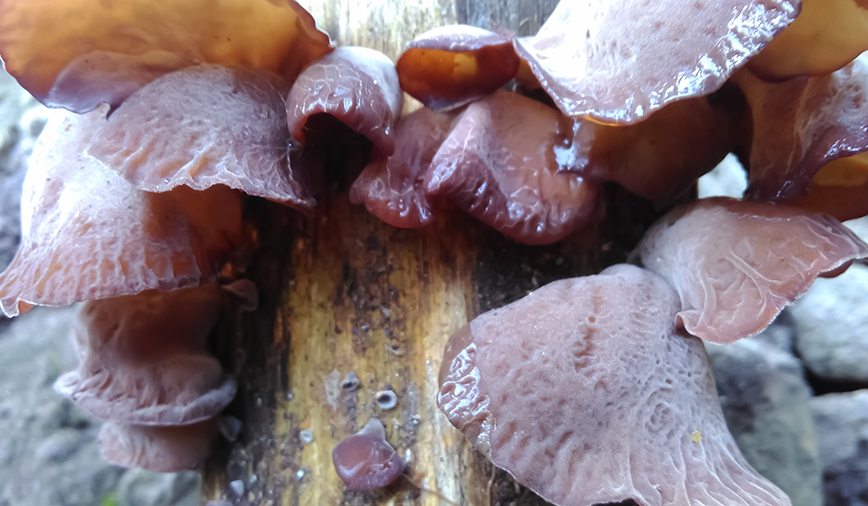“Just add water.”
Not only is that directive my favorite kind of recipe, it’s also the formula for springtime flora…and fungus.
This past week’s rains have our woodland wildflowers—spring beauties, hepatica, twinleaf and bloodroot, to name a few—grabbing lots of attention in the Native Plant Garden at Pottawatomie Park. But a few astute visitors have noticed that some pretty spectacular fungi also are reaping the benefits of our recent April showers.
Two fungi in particular are in fine form these days: tree ear, (Auricularia spp.) and witch’s butter (Tremella mesenterica).
I’m usually a fan of scientific names, because they’re not subject to colloquialisms. Tremella mesenteria is called Tremella mesenterica here in Kane County, in Kankakee, in Kansas, even in Kazakhstan. But, let’s face it, that name is a mouthful. Besides, the common names of these fungi are fairly widely distributed, and describe them perfectly.
Bark colored and semi-circular in shape, tree ear looks just like its name. Along those same lines, witch’s butter is yellowish orange. Freshly hydrated, it does indeed look like butter; after a while, it softens and its colors deepen, and starts to look like marmalade. Either way, it doesn’t take a whole lot of imagination to picture Broom Hilda spreading some on her toast in the morning.
Both these organisms belong to a group known as the jelly fungi. Soft and somewhat squishy, they have the texture of Gummi candy that’s been soaked in a can of Dr Pepper for an hour. (We won’t go into detail as to how I know this; let’s just say that working with kids can lead to some interesting discoveries…)
Although both tree ear and witch’s butter can be found growing on dead oak branches, the two fungi are quite different. Tree ear is saprobic, meaning it gains its nourishment by decomposing the dead wood it lives on. But witch’s butter is parasitic—it makes a living feeding off of another type of fungus on the decaying wood.
If you’re interested in seeing these local fungi, head to an area that has lots of old oak trees. Scan the dead branches on the ground. Tree ear usually is the more common species, but is harder to pick out due to its drab color. Witch’s butter is seen less
frequently, but its bright yellow and orange hues are hard to miss.
If you’re only able to find branches with dark brown or orange crust-like growths, don’t despair. What you’ve found are dried-out jelly fungi. To make them reappear, all you need to do is…just add water.
If fungus isn’t your thing, but coyotes are, make sure you plan to attend the April meeting of the Kane County Audubon Society. Chris Anchor, wildlife biologist with the Cook County Forest Preserve District, is returning with an update on the ongoing urban (and suburban) coyote research being conducted in the Chicago area. His presentation last year drew a big crowd, and similar numbers are expected this year.
In anticipation of this large audience, Kane County Audubon has partnered with the St. Charles Park District to host this month’s program at the Pottawatomie Community Center, 8 North Ave., St. Charles. The meeting is this Wednesday, April 14 at 7 p.m.—but plan to get there a few minutes early if you’d like a good seat. The meeting is free, and you do not need to be a member of Audubon to attend.
Pam Otto is the manager of nature programs and interpretive services for the St. Charles Park District. She can be reached at potto@stcparks.org or 630-513-4346.

